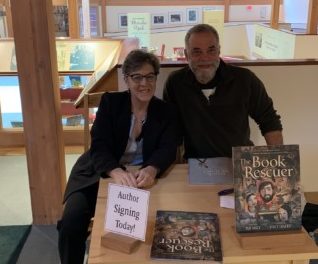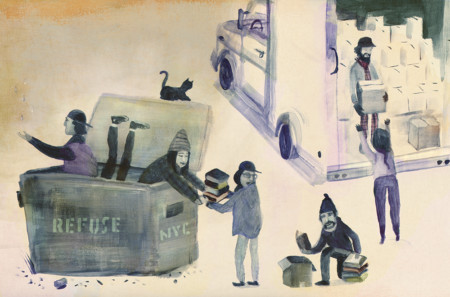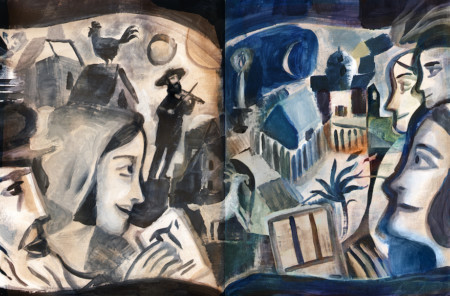
To draw creative images corresponding with a picture book text is a special talent. Not only does it require artistic skill but it also is dependent on the illustrator’s ability to translate the author’s words into images.
Today, I introduce Stacy Innerst, an accomplished artist and illustrator. After extensive research, he was able to effectively capture the essence of Jewish culture in the award-winning picture book, The Book Rescuer: How a Mensch from Massachusetts Saved Yiddish Literature for Generations to Come. To learn more about the book, read the book review and to become acquainted with the author, Sue Macy— read her author interview.
When did you determine that your love for art would lead to a profession?
Since I was a kid, I was determined to make a living with my picture-making. It wasn’t easy. I had a series of, let’s call them, “menial” jobs after college before my first break as a designer/illustrator at a Public TV station in New Mexico. Since then I’ve always worked as an artist in some capacity. I think working hard at unpleasant jobs early on has made me appreciate what I get to do for a living.
When and where did you receive your formal art training?
I studied fine art, mostly art history, painting and drawing, at the University of New Mexico. That experience gave me a strong foundation in technique but I’m really self-taught as an illustrator. My university did not offer illustration classes. I actually think that helped me to find my own vision as an illustrator. I also had wonderful art teachers in grade school. New Mexico was a great place to grow up as an artistic kid.
With so many artistic options available, why did you decide to narrow your focus to becoming an illustrator of picture book biographies?
I worked as an editorial illustrator for newspapers, magazines, and television documentaries for years before I illustrated my first book. My interest in picture books developed when my own kids were small and I was reading to them at bedtime. Some of the most interesting artwork was in those books. Also, I’ve always loved to read history, especially biographies. My first two books were not biographies. For the last several years, I illustrated fascinating stories about real people.
Your website mentions that you are also a painter and educator? Can you briefly describe your work in these fields?
Well, I’ve always considered myself a painter first because that’s what I fell in love with at the beginning. There is something special about the way paint behaves on a surface that can be so expressive and visceral. It’s hard to capture in words.
I also like the unpredictable messiness of the process until something mysteriously appears and you have that satisfying moment of success. I show my work at a couple of U.S. galleries. It’s a different experience entirely because each work is singular. Each picture has to stand for itself, not as part of a collaborative product.
I teach illustration at a small private university called La Roche in Pittsburgh. I love to visit schools and talk about art and books with kids. They’re my audience!
Can you describe any challenges you faced when you first tried to enter the book illustrator market?
It was a stretch going from editorial illustration to making books for kids. I’m not going to lie. I was working as an illustrator at a Seattle newspaper and a published author, who saw my work in the paper, introduced me to her Harcourt editor in San Diego.
She was willing to give me a chance on a picture book but it took about two years before she found one that was right for my rather unusual style. The book was well-received without an agent. There were long stretches where I didn’t get any book contracts. I started to think I was washed up! Now I have a wonderful agent, Susan Cohen at Writers House. Things seem to be chugging along.
Can you share the main steps you take when creating images for a picture book?
I usually start with a stylistic theme, much like an art director would for a film. That usually determines the color pallet, the texture and the medium I use. For a book about Levi Strauss, I painted the illustrations on blue jeans. Another book focusing on George Gershwin composing Rhapsody in Blue had paintings entirely in blue.
The research is pretty extensive for historical biographies because the details matter. Even though my illustrations aren’t terribly detailed and are painterly, I am accurate about the time and place I’m trying to depict.
My initial sketches are very loose but I try to give the editor/art director a good sense of the composition and flow. If needed, I also send reference materials to ensure historical accuracy. I often send color swatches and more detailed character sketches, too.
I go back and forth with the editor and art director until everyone is on the same page.
Do you have complete control over the style of the illustrations or do publishers and/or authors provide input, recommendations or specific guidelines?
Fortunately, I’ve been doing this for a while so publishers are familiar with my style. I have free reign in conceptualizing and illustrating the stories. Authors are pleased with the result so far!
The wonderful authors I’ve worked with put their trust in editors and art directors to choose the illustrator that they feel is the best match for the story and subject. Ultimately, it’s a collaboration between the author, the artist and the publishing house and I think it works best when everyone brings their own gifts and vision to the process. When there is harmony, it’s a beautiful thing.

Since you were unfamiliar with Aaron Lansky and Yiddish culture, what resources did you use to acquaint yourself with this segment of Jewish history?
I did a lot of my research online, starting with the mountain of online resources at the Yiddish Book Center. Aaron is roughly my age. I had a pretty good idea what his childhood/young adult world looked like. Photos of him as a bearded young man in a T-shirt, jeans, boots, and a bandana came in handy. That was the image that I settled on to depict him in his early book collecting, “dumpster-diving” days. I used artifacts from my own childhood as a model to decorate his room.
To gain an understanding of Yiddish culture I watched a lot of Yiddish films from the 30s and 40s like Green Fields. I studied the book covers of Yiddish novels and plays. Also, I was a history minor in college. I studied a lot of Jewish history because I had a passionate professor whom I respected. He specialized in the subject so I took all of his classes. I ended up with some useful fragments of knowledge that I could apply to the process.
In addition to learning more about Marc Chagall, did your research lead to learning about Eastern European Jewish artists? If so, can you elaborate?
Not so much Eastern European Jewish artists but I’ve always been a fan of the paintings of Jewish artists like Modigliani, Chaim Soutine and Pissaro, to name a few. As a student, I was interested in the Abstract Expressionists. Later, as a draftsman few could match R.B. Kitaj.
Marc Chagall was my touchstone because he offered such a clear look into the poetic, Yiddish world. I was determined to let him visually “translate” some of that experience for me. I also relied for inspiration on Yiddish book illustrations from the digital collection at the YBC. Beautiful stuff.
Many of my readers are not artists. Can you identify images inspired by Chagall’s incredible talent? Why did you select this style and color tones?
Chagall had a way of painting life that incorporated the artistic freedom that I’ve always tried to use in my art. His scenes weren’t bound by gravity and realism. Instead, they had a kind of mystical quality to them. I think kids (and some adults) can really respond to that kind of freedom in pictures.
His color and compositions were incredibly sophisticated and I knew I couldn’t match that virtuosity but I borrowed some of his pallet and motifs like roosters, goats, windows and floating people/objects in my illustrations.
A few of the illustrations borrowed heavily from his painting style. This is seen in my drawings depicting shtetl life, Jews fleeing Europe during the Second World War, and most pointedly the last spread in the book which depicts the handing down of Yiddish culture from the past to the present.
Earlier this year, The Book Rescuer received a Sydney Taylor Award. What other awards have you received for your picture book illustrations and how have these awards impacted your career?
The Sydney Taylor Award is an incredible honor for books which AUTHENTICALLY portray the Jewish experience. For me, it kind of validated the love and effort Sue Macy and I put into the book.
Awards and recognition certainly help propel your career in children’s publishing. Some of them are juried by respected professionals and some by your peers in the business. Either way, they put a spring in your step and allow you to believe that maybe you are pretty good at what you do!
I’ve been fortunate to have received several awards for my books over the years such as a Best Illustrated Children’s Book Award by the New York Times, The Golden Kite Award from the SCBWI, Parents’ Choice Gold Medals, and inclusion on many notable and “best of” book lists.
Can you share information about upcoming book releases? (Titles, types of images, proposed publication dates, etc)
In March 2020, Saving Lady Liberty, a book about how Joseph Pulitzer crowdfunded the pedestal for the Statue of Liberty (by Claudia Friddell) was published. Lincoln Clears a Path, by Peggy Thomas is scheduled for a January 2021 release.
I’m currently working on a few titles, one of which I’m writing and illustrating. I’m also illustrating a story about the first harrowing U.S Airmail flight by pilot Jack Knight, for Boyds Mills Kane ( 2021) and a book about Ben and Jerry of ice cream fame for Abrams Books (2022).
DISCLOSURE
I received a complimentary copy of The Book Rescuers: How a Mensch from Massachusetts Saved Yiddish Literature for Generations to Come.
BIO
Sandra Bornstein is the author of May This Be the Best Year of Your Life. Sandra’s memoir highlights her living and teaching adventure in Bangalore, India. She was a licensed Colorado teacher who taught K-12 students in the United States and abroad. Sandra also taught college-level courses at Front Range Community College and the University of Colorado-Boulder.
In addition to reviewing books and interviewing authors, Sandra is an award-winning author and lifestyle and travel journalist. Many of Sandra’s travel stories appear on the For Readers Page. TheTravelingBornsteins website showcases recent travel and lifestyle stories.


Connect with Sandra